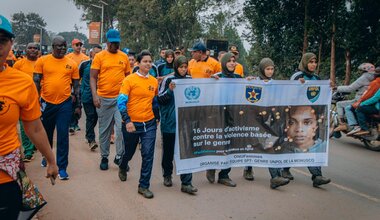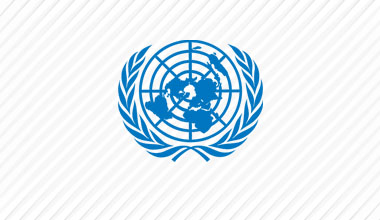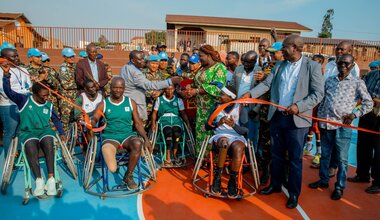ITURI : MORE THAN 350-KM ROADS REHABILITATED BY MONUSCO SINCE 2019, TO FACILITATE PROTECTION OF CIVILIANS AND TO BOOST TRADES
Since 2019, MONUSCO, through the Nepalese engineers’ company of its Force, has rehabilitated over 350-km roads in Ituri province. This is not its main mission, but part of the civilians’ protection, which is the core of its mandate. They are not highways either, but agricultural feeder roads or “national roads” sections of strategic importance, economic, social, and security-wise.
Most of these road sections were heavily damaged. Their advanced state of disrepair used to slow down interventions by the security forces in their fight against armed groups. Sometimes, to cover 5 km, peacekeepers or FARDC troops would take 30 to 45 minutes: too long to save lives in danger of death.
Beyond the purely security aspect, the poor state of the roads did not allow free movement of people and their goods. It also exposed the population to attacks from armed groups who took advantage of the quagmires to attack civilians using these roads.
In other localities, local authorities reported the difficulties faced by communities in selling their farming products, which impoverishes them even more, with all the consequences that one can imagine: youth unemployment, some of whom would heed armed groups’ calls; children unable to go to school for lack of means; the populations could not afford, due to lack of income, and farming products which would sometimes rot in the village due to lack of roads for evacuation to urban centers.
Irumu and Djugu: Priority to Civilians’ protection
In consultation with provincial authorities, alongside whom MONUSCO is leading a difficult fight to eradicate armed groups, Nepalese peacekeepers have refurbished several road sections, mainly in the territories of Irumu and Djugu, which are among the most affected by insecurity in Ituri. The rehabilitated roads by MONUSCO include, inter alia:
Bogoro - Kasenyi in March 2020, 11-km long; Irumu - Komanda in November 2019 (2 km but which were in an indescribable state of disrepair, just like Komanda - Idohu, 153 meter-road, a real ordeal for users); Tchabi - Kainama in the territory of Beni, North Kivu (16 kms); Gina - Fataki in January 2022 (40 kms); Tshabi - Kainama in March 2021 (16 kms); Bunia - Shari - Budana in October 2022 (17 kms); Kagaba-Ngasu Odje (9 km); Katoto - Lita - Luna - Djili in March 2022 (12 kms); Olongba-Songokoy (11 km); Bogoro-Aveba in 2019 (45 km); Bogoro-Kasenyi in 2019 for 26 kms.

On top of these, several roads’ sections in the town of Bunia have received a facelift from MONUSCO as well as the road section that surrounds Bunia airport runway (3.5 km). According to the Airway Authority (RVA) commander, a recipient of this work, the practicability of this road not only makes it possible to reinforce the safety of the runway, but also to facilitate the mobility of fire trucks in the event of an emergency. Since October 21, MONUSCO has undertaken the rehabilitation of 75 km-long road sections Bunia - Marabo - Komanda.
The beneficiaries of these MONUSCO actions did not hide their joy. Such is the case for the Tsere group leader in the territory of Irumu, Zamundu Batagura Mugenyi. “Here, in the vicinity of Rwampara, we have an FARDC camp: it was difficult for the troops to move and intervene on time in the event of attacks or threats from the FPIC militia, due to the poor state of the road. But since MONUSCO has rehabilitated this road, FARDC now intervene more easily”, he said on October 20, after the rehabilitation of the Bunia-Budana-Shari road. “Cases of accidents are no longer reported, even the sick are more easily transported to the Rwampara referral hospital, which saves lives,” he further said.
Zamundu Batagura Mugenyi also mentioned the economic advantages: “Our agricultural products from Tutu or Tshabusiku are now also much more easily transported to the various markets in Bunia. This helps improve people’s living conditions. Before, to transport a single bag of beans from these localities to Bunia, it was very tough, because of the poor condition of this road. Today, we are happy, everything is going very well and quickly. We say thank you again MONUSCO”.
Bridges, in addition to roads…
In addition to these road sections, bridges are also built or renovated by the Nepalese blue helmets. In May 2022, the Mission handed over three bridges and six culverts to the local authorities in the Zadu and Baviba groupings, 60 kilometers from Bunia. The bridges are located between Ati and Adjiri rivers and serve eight villages whose inhabitants had the greatest difficulty in evacuating their rural products and getting basic food and non-food supply.
To build this infrastructure, MONUSCO called on local workforce of some 1,500 young people at risk, including ex-combatants and community members. This had then made the vice-president of civil society in Walendu Bindi, Daniel Masumboko Ndrudro, say “thanks to these achievements, the entities that have long been landlocked are no longer so today. Vehicles can drive through thanks to the bridges built, the population of Walendu Bindi are very happy for they will no longer carry heavy goods on the head”.
Justin Makambo, a young man from Getty, believes these works have improved the lives of the beneficiary populations. "People are now spending less time on the roads, which was not the case before; they had to walk from one place to another, which contributed to increasing travel time and therefore the risk of falling into a militiamen ambush,” he explained.
Rehabilitation of communication infrastructure, one of the levers for the protection of civilians
We may as well mention, besides the examples above, the bridge over the Shari River in Mwanga 7 km from Bunia or the "reconciliation bridge" built by the Nepalese blue helmets in March 2021 in the territory of Irumu, whose impacts on the life of the local population is very positive; furthermore, this has improved relationship between the populations of Mobala and Bahema chiefdoms in Irumu.
The beneficiaries say this work has brought together communities from the two chiefdoms who used to live almost separated from each other as the bridge could not be used. The chief of Mobala chiefdom explained "for years, people were forced to leave their cars or motorcycles on the side of the road and cross the river on foot, on persons’ back or on board canoes during the rainy season”, and expressed the wish to see “this bridge serve as a real connection between the two communities”.

 UN
UN United Nations Peacekeeping
United Nations Peacekeeping






